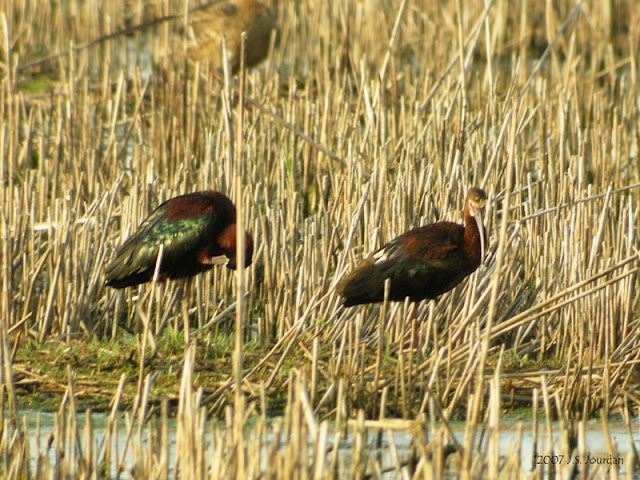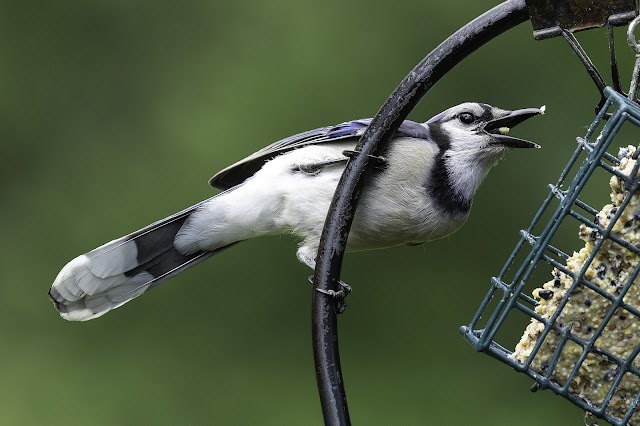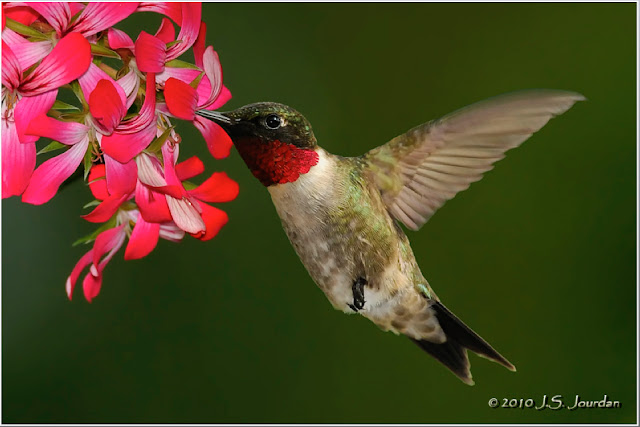Plegadis Ibis at Pt. Mouillee - 10 Jun 2007

Reports from Pt. Mouillee the last few days have included a number of wonderful birds: (up to 11) Glossy Ibis, (1) White-faced Ibis, (2) King Rails, (1) Cinnamon Teal, (3) Whimbrel, (3) Yellow-headed Blackbirds, (6) Least Bitterns, (1) Yellow-crowned Night Heron, (3) Black-bellied Plovers, (1) Laughing Gull and (1) Willet. Kudos to folks like Will Weber, Adam Byrne and Brad Murphy for the great finds.
I finally got down there Sunday evening to get in on the action. I arrived at the Mouillee Creek parking lot around 5:30 pm and headed up the Middle Causeway toward the Vermet and Lead Units where most of the birds have been sighted. With temps in the mid 80’s and mostly clear skies it was a wonderful afternoon to be out. Winds were a bit on the breezy side, but not too terrible for a late afternoon.
Several small families of Canada Geese were everywhere. As I approached the Vermet Unit I spotted a single drake Blue-winged Teal approximately 60 yards away on the edge of a small drainage ditch. Having just purchased a new Nikon Coolpix P5000 digital camera I had the opportunity to try it out from a distance. The teal proved cooperative and several nice portrait shots were obtained from a distance. A singing Indigo Bunting another 60 yds. or so proved a bit more challenging in the swaying phragmites. A Great Egret flew overhead and soared within D70 / 400 mm range.
Several small families of Canada Geese were everywhere. As I approached the Vermet Unit I spotted a single drake Blue-winged Teal approximately 60 yards away on the edge of a small drainage ditch. Having just purchased a new Nikon Coolpix P5000 digital camera I had the opportunity to try it out from a distance. The teal proved cooperative and several nice portrait shots were obtained from a distance. A singing Indigo Bunting another 60 yds. or so proved a bit more challenging in the swaying phragmites. A Great Egret flew overhead and soared within D70 / 400 mm range.
Upon arriving at the SW corner of the Vermet Unit I immediately spotted a group of (6) Glossy Ibis on the mud spit that extends out into the middle of the Unit. Two more Glossy Ibis were a bit farther to the south and east of this group. I ran into Skip Zabel who pointed out the White-faced Ibis to me. This bird was about 200-250 yds. away and proved difficult to digiscope. But I managed a few record shots from this distance. 10 Mbytes helps from this distance, so the P5000 earned its keep. The White-faced Ibis distinguished itself from the Glossy Ibis by having a broader white patch around the base of the bill, and even from 200 yds. the red iris and red skin patch at the base of the bill were distinctive.
After about 10 minutes of scoping all nine birds took off simultaneously. I managed a couple flight shots before they headed off due north, and appeared to ride the thermals for a while. This gave us time to scope the rest of the mud spit and see several Ruddy Turnstones, Caspian Terns, Black Terns, a Willet, and several Dunlin. The Laughing Gull was not visible, and no Cinnamon Teal was seen. After several minutes the Glossy Ibis returned, landing farther out toward the middle of the Vermet Unit, so I headed off toward the north to look for Whimbrels and other interesting birds.
Cell 4 of the Banana Unit held a nice male Ruddy Duck, but I was too slow to digiscope it before it disappeared out into the middle of the cell. A stop at the mud spit at the north end of Cell 3 was a mixed bag: recent dredgings were piled high in this area, and the black mud/sludge both smelled of anaerobic detritus and asphalt, and raised the surrounding temperatures a good 10 degrees. A few Redhead Ducks and Semipalmated Sandpipers were at the tip, but too far to digiscope. I managed a pic of a Mute Swan along shore while a small flock of Purple Martins courted and chased each other nearby. I managed a flight shot of a female fly-by, and then tried to get pics of several Black Terns that flew past. By now the smell was giving me a headache, so I got out of there.
The Middle Causeway held a number of Red-winged Blackbirds, and I took a few minutes to digiscope a cooperative female from about 30 yds. A displaying male Red-wing flared its bright red epaulets at just the right time and allowed me a pic from about 20 yds. away. Another chance to digiscope Indigo Buntings occurred a few minutes later. Overhead I could hear the Willet cry its “Pill-will-willet” call as it flew by, and I was able to get a nice view of its black-and-white wing patches.Along the south side of the Vermet Unit I spotted several of the Ibis, and was able to get a closer pic of the White-faced Ibis next to a Glossy Ibis. A screaming, bug-eyed Black-crowned Night Heron flew overhead, and it looked as if it were choking on its last meal. Unable to see any Yellow-headed Blackbirds or Yellow-crowned Night Herons I headed back to the car. A singing Swamp Sparrow and Marsh Wren along Mouillee Creek made for a nice ending to a short outing.





Comments
Post a Comment
Please leave a comment. I will try to respond ASAP.